Mooring Lines – Horses for Courses
Choosing the right types of mooring lines depends on a number of factors including the type of mooring and the length of time that the yacht will remain moored. This article by Jimmy Green Marine, looks at the factors to consider in deciding which type of line is best for the job.
Published 5 months ago
Mooring up commonly relates to the various methods of securing your yacht to a fixed point. First, look at some examples, because each application will have different pros and cons.
Mooring Applications
Mooring alongside, also known as Docking, usually refers to a yacht lying with the topsides adjacent to a pontoon, jetty, or seawall. This method of tying-up generally features multiple forward, stern, and central lines to divide the strain and constrain a yacht’s movement.
Mooring stern-to, also known as Mediterranean-style (because it is common in those parts), refers to a yacht lying perpendicular to the pontoon or fixed dock with either its stern or bow facing the dock (this is the choice of the skipper depending on privacy concerns and ease of getting ashore). Either stern, or bow, mooring lines will be fixed to the dock and a laid anchor line (or the yachts own anchor) is used to keep the vessel pointing perpendicular to the dock (and away from the dock for safety).
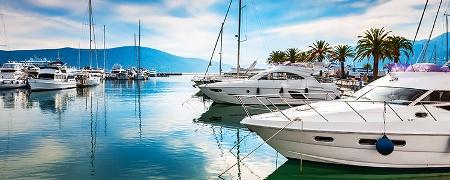

A Swinging Mooring, also known as an anchor mooring, commonly refers to a yacht lying with her bow to a mooring buoy connected to a permanent fixture on the seabed.
Because the mooring is to a single point, the yacht can turn full circle in either direction according to the wind and tide and continue turning at the mercy of the prevailing weather and current. The buoy may be a yacht’s home berth or a visitor’s mooring. A yacht is generally attached to the mooring buoy with a substantial, chafe-protected mooring rope commonly referred to as a strop or a bridle.
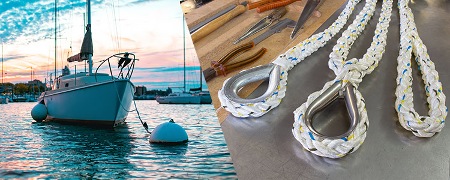

A Trot Mooring is where a yacht is tethered fore and aft to a line of mooring buoys or piles driven into the bottom of the sea or riverbed in a straight line. The bow and the stern are tied to the buoy or a heavy steel ring on the pile (which may slide up and down with the tide).
Mooring Duration
The length of time that the yacht will remain moored is a principal element in deciding which type of line is best for the job, especially if the yacht will be unattended for prolonged periods. The duration factor can be loosely divided into ‘permanent’ or ‘visiting’ mooring.
Permanent Mooring Lines
Permanent will tend to be for home berths, whether in a marina or on a buoy. Good-quality mooring lines should have adequate abrasion resistance, but some rope constructions are marginally less susceptible to snagging and chafing than others. Permanent mooring lines tend to be shorter, even made up with splicing to specific lengths. They should also be larger in diameter for peace of mind to allow for the extra workload and potential damage from severe weather while you are away. To summarise – larger, stiffer, harder, and less pliable means more durable and, therefore, more suited to permanence, but less manageable.
Visiting or Docking Lines
Visiting mainly covers docking and tying up for a short stay, but can include tying up to buoys and trots on a temporary basis. At the other end of the ‘abrasion resistance to handling’ scale, you can pick a pliable fibre and construction that you and your crew enjoy handling, coiling, stowing, and throwing.
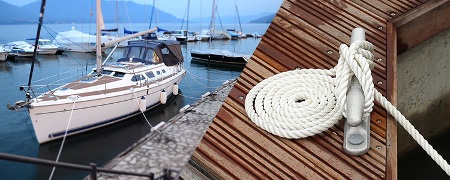

Stretch Factor
Mooring lines need to absorb the repetitive load surges caused by wind, waves and current and maintain the capacity to regain their constructional integrity without suffering premature stress failure. Polyester has the desired degree of working stretch for mooring. Polypropylene stretches well, and if anything, slightly more than polyester, but it has other disadvantages. Nylon has 5-10% more elongation than polyester, which may be advantageous when conditions result in excessive movement. For all ropes, the ability to absorb surge loads can be enhanced with mooring compensators.
Strength and Durability
The strength required of each mooring line depends on your chosen configuration, effectively the number of ropes that divide the load. Therefore, the diameter and break load are key factors. For a typical 35-footer, you would expect the docking lines to be around 14mm diameter, but a single mooring strop to be around 24mm diameter.
Nylon is initially the strongest fibre used to produce mooring lines, but the breaking strain may reduce by as much as 10-15% when it dries after a thorough dowsing in fresh or saltwater. That initial tensile strain advantage over Polyester diminishes marginally with each season due to Polyester having a better UV resistance. In fact, Polyester has about the best UV resistance of all the rope fibres used in yachting and boating.
Higher resistance to the sun’s harmful rays means a longer working life and, consequently, a considerable cost benefit. Buying cheap is not cost-effective if you replace it much sooner than you had hoped. Polypropylene is just not comparable to Polyester and Nylon and should not be considered unless stepping up in diameter for applications requiring the rope to float.
Abrasion Resistance
The capacity of any rope to resist wear and tear depends on what the rope is made from, how it is manufactured and, to a lesser extent, the finished construction. Polyester and Nylon have comparable performance in terms of natural chafing resilience. Polypropylene is again a distant third. LIROS employ heat setting technology and special twisting techniques on the fundamental filaments and yarns to enhance wear performance.
Nylon shrinks when it dries out after immersion, resulting in a tightening of the rope strands, creating a harder, stiffer rope. This can be of benefit for permanent single-purpose warps.
LIROS Handy Elastic, pictured below, is perhaps the epitome of the ‘best of all worlds,’ combining the stretchiness and abrasion resistance of nylon with maximum strength and the handling advantages of a double braided Dockline.
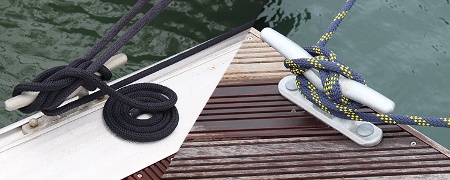

Comfort
Rope construction and diameter make a difference when handling a rope, especially for more delicate hands. Braided Dock Lines are commonly regarded as the most supple, luxurious handling rope for mooring. Twelve-strand Hollowbraid construction, e.g. LIROS Moorex12 (pictured below), is the most flexible option. Octoplait (Anchorplait) eight-strand plaited ropes are also pliable and comfortable to handle. A three-strand rope is generally considered more awkward and less kind to the hands. Still, it is less expensive than the braided and plaited options, making it generally the best all-round choice for most mooring applications.
Handling, Coiling and Hanking
The rope construction dictates how to hank a rope into a coil for stowing, throwing, or heaving. A three-strand rope must be rolled around your thumb to keep the lay in the designed format. Braided and Plaited ropes should be allowed to fall naturally, sometimes into a figure-of-eight shape, to ensure that you are not imparting a twist into the rope.
If you stick to these principles, you should avoid the worst snarl-ups. A neat hank looks smart, but it is not the best way to stow a rope ready to deploy because unless you are incredibly careful as you let the rope out, you will catch some loops and end up with a right old mess. Stuffing a lengthy line into a bag, bucket, or similar stowage container will be by far the best way to ensure that it emerges freely without any loops, kinks, or tangles.
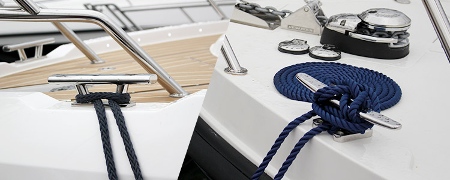

UV Resistance
Everything deteriorates in the sun. The speed at which the degeneration occurs depends on what the rope is produced from. Polyester is best, with nylon a reasonable second and polypropylene a distant third. UV stabilising techniques help, but do not significantly alter the general comparable resistance values of the three different fibres. Counteracting UV degradation should be a major consideration for yachts in the Mediterranean and the Tropics.
Buoyancy
Polyester and Nylon sink. Polyester is slightly heavier than nylon. Polypropylene floats. There are some applications where it is important that a line floats on the surface, but otherwise, Polyester and Nylon are far more durable fibres in terms of strength and resistance to abrasion and UV.
Single-Purpose or Multi-Purpose Mooring Lines
Single Purpose Mooring Lines
These are ropes that you keep for a specific application, i.e. a particular aspect of your mooring set-up. These can be made up to a specific measurement, spliced and finished to suit your home berth. These lines tend to be for permanent arrangements, also known as Permanent Warps.
Multi-Purpose Mooring Lines
These are ropes of a handy, but not specific, length and diameter to cover any eventuality when docking. You are likely to throw, handle and make off these lines the most. A handy mooring line will probably be at least the length of the boat or up to one and a half times the boat’s length. A pair of longer rafting warps are also a useful addition to any rope locker. These are longer lines which will reach the pontoon when you are moored outside one, or even multiple, visiting yachts.
Summary
Polyester is the best all-round fibre for mooring applications. Nylon has additional elasticity and can develop a harder finish, which can be beneficial for certain solutions. Polypropylene does not match up at all and should only be chosen if you need it to float.
Pick your mooring lines according to whether they are single-purpose or multi-purpose. Abrasion resistance is likely to be the most important property of the former, whereas comfort in the hand will be of more concern for the latter.
…………………………
About the Author
Jimmy Green Marine is a family-run business founded by brothers Alistair and Mike Green, based in the coastal fishing village of Beer in East Devon. The company started as a Mail Order Chandlers in 1981 and has continually evolved from attending Boat Shows and Boat Jumbles in the early days to now trading globally online.

Four decades of exporting experience combined with an intuitive website shipping calculator means that you can have your order delivered to your home, business or direct to your yacht anywhere worldwide.
Their flagship, innovative Custom Build website system provides an instant quote for all your professionally spliced and finished wire and rope rigging, mooring and anchoring solutions.
You can access this online from wherever you can get an internet connection, however remote.
Alistair Green is an experienced sailor and rigger with over 40 years of experience in the marine industry. He is passionate about providing his customers with the best possible products and services and is always looking for new ways to improve the business.
If you are looking for a reliable and experienced marine supplier, then Jimmy Green Marine is the perfect choice.
Visit their website today to learn more about their products and services.
…………………………
Related Links:
- About Jimmy Green Marine
- Custom Splicing, Rigging and Sewing Service
- Worldwide Shipping
- Jimmy Green Marine joins Noonsite.com as Official Ropes and Rigging Partner (April 2023)
Other Articles by Jimmy Green Marine:
- When to Replace your Standing Rigging (October 2023)
- Ten Reasons to Whip and Stitch Your Ropes (September 2023)
- How to Choose your Next Anchor Chain (August 2023)
- How to Choose a New Halyard (July 2023)
- The Uses and Benefits of Rope Splicing Onboard a Yacht (May 2023)
………………………………
The opinions expressed in this article are the author’s own and do not reflect the view of Noonsite.com or World Cruising Club.
………………………………
Find out all news, reports, links and comments posted on Noonsite, plus cruising information from around the world, by subscribing to our FREE monthly newsletter. Go to https://www.noonsite.com/newsletter/.
Related to the following Cruising Resources: General, Marine Supplies, Planning and Preparation

